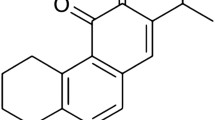Abstract
The aim of this study was to systematically examine the inhibitory mechanisms of ketamine in platelet aggregation. In this study, ketamine concentration-dependently (100–350 µM) inhibited platelet aggregation both in washed human platelet suspensions and platelet-rich plasma stimulated by agonists. Ketamine inhibited phosphoinositide breakdown and intracellular Ca2+ mobilization in human platelets stimulated by collagen. Ketamine (200 and 350 µM) significantly inhibited thromboxane (Tx) A2 formation stimulated by collagen. Moreover, ketamine (200 and 350 µM) increased the fluorescence of platelet membranes tagged with diphenylhexatriene. Rapid phosphorylation of a platelet protein ofMr 47,000 (P47), a marker of protein kinase C activation, was triggered by phorbol-12,13-dibutyrate (100 nM). This phosphorylation was markedly inhibited by ketamine (350 µM). These results indicate that the antiplatelet activity of ketamine may be involved in the following pathways. Ketamine may change platelet membrane fluidity, with a resultant influence on activation of phospholipase C, and subsequent inhibition of phosphoinositide breakdown and phosphorylation of P47, thereby leading to inhibition of intracellular Ca2+ mobilization and TxA2 formation, ultimately resulting in inhibition of platelet aggregation.
Similar content being viewed by others
References
Atkinson PM, Taylor DI, Chety N. Inhibition of platelet aggregation by ketamine hydrochloride. Thromb Res 40:227–234;1985.
Berridge MJ. Rapid accumulation of inositol trisphosphate reveals that agonists hydrolyse polyphosphoinositides instead of phosphatidylinositol. Biochem J 212:249–258;1983.
Born GVR, Cross MJ. The aggregation of blood platelets. J Physiol 168:178–195;1963.
Broekman MJ, Ward JW, Marcus AJ. Phospholipid metabolism in phosphatidyl inositol, phosphatic acid and lysophospholipids. J Clin Invest 66:275–283;1980.
Chesney CM, Pifer DD, Cagen LM. Triazolobenzodiazepines competitively inhibit the binding of platelet activating factor to human platelets. Biochem Biophys Res Commun 144:359–366;1987.
Grabarek J, Raychowdhury M, Ravid K, Kent KC, Newman PJ, Ware JA. Identification and functional characterization of protein kinase C isozymes in platelets and HEL cells. J Biol Chem 267:10011–10017;1992.
Grynkiewicz G, Poenie M, Tsien RY. A new generation of Ca2+ indicators with greatly improved fluorescence properties. J Biol Chem 260:3440–3450;1985.
Hirakata H, Nakamura K, Sai S, Okuda H, Hatano Y, Urabe N, Mori K. Platelet aggregation is impaired during anaesthesia with sevoflurane but not with isoflurane. Can J Anaesth 44:1157–1161;1997.
Hornby EJ. Evidence that prostaglandin endoperoxides can induce platelet aggregation in the absence of thromboxane A2 production. Biochem Pharmacol 31:1158–1160;1982.
Huang TF, Sheu JR, Teng CM. A potent antiplatelet peptide, triflavin, fromTrimeresurus flavoviridis snake venom. Biochem J 277:351–357;1991.
Huang TF, Sheu JR, Teng CM. Mechanism of action of a potent antiplatelet peptide, triflavin, fromTrimeresurus flavoviridis snake venom. Thromb Haemost 66:489–493;1991.
Karniguian A, Legrand YJ, Caen JP. Prostaglandins: specific inhibition of platelet adhesion to collagen and relationship with cyclic AMP level. Prostaglandins 23:437–457;1982.
Kitagawa S, Shinohara T, Kametani F. Effects of alcohols on ADP-induced aggregation and membrane fluidity of gel-filtered bovine blood platelets. J Membrane Biol 79:97–102;1984.
Kobayashi T, Yamada J, Setaka M, Kwan T. Effects of chlorpromazine and other calmodulin antagonists on phosphatidylcholine-induced vesiculation of platelet plasma membranes. Biochim Biophys Acta 855:58–62;1986.
Kohro S, Yamakage M. Direct inhibitory mechanisms of halothane on human platelet aggregation. Anesthesiology 85:96–105;1996.
Kornecki E, Ehrlich YH, Lenox RH. Platelet-activating factor-induced aggregation of human platelets specifically inhibited by triazolobenzodiazepines. Science 226:1454–1456;1984.
Kraft AS, Andersion WB. Phorbol esters increase the amount of Ca2+, phospholipid-dependent protein kinase associated with plasma membrane. Nature 301:621–623;1983.
McDonald LJ, Murad F. Nitric oxide and cyclic GMP signaling. Proc Soc Exp Biol Med 211:1–6;1996.
McKean ML, Smith JB, Silver WJ. Formation of lysophosphatidylcholine in human platelets in response to thrombin. J Biol Chem 256:1522–1524;1981.
Nakagawa T, Hirakata H, Sato M, Nakamura K, Hatano Y, Nakamura T, Fukuda K. Ketamine suppresses platelet aggregation possibly by suppressed inositol triphosphate formation and subsequent suppression of cytosolic calcium increase. Anesthesiology 96:147–152;2002.
Park GR, Manara AR, Mendel L, Bateman PE. Ketamine infusion: its use as a sedative, inotrope and bronchodilator in a critically ill patient. Anaesthesia 42:980–983;1987.
Pribluda V, Rotman A. Dynamics of membrane-cytoskeleton interactions in activated blood platelets. Biochemistry 21:2825–2832;1982.
Sheu JR, Hsiao G, Shen MY, Fong TH, Chen YW, Lin CH, et al. Mechanisms involved in the antiplatelet activity of magnesium in human platelets. Br J Haematol 119:1033–1041;2002.
Sheu JR, Hung WC, Kan YC, Lee YM, Yen MH. Mechanisms involved in the antiplatelet activity ofEscherichia coli lipopolysaccharide in human platelets. Br J Haematol 103:29–38;1998.
Sheu JR, Hung WC, Lee LW, Chang PT, Kan YC, Yen MH. Mechanisms involved in the antiplatelet activity of naloxone in human platelets. Biochem Biophys Res Commun 231:12–16;1997.
Sheu JR, Hung WC, Wu CH, Ma MC, Kan YC, Lin CH, et al. Reduction in lipopolysaccharide-induced thrombocytopenia by triflavin in a rat model of septicemia. Circulation 99:3056–3062;1999.
Sheu JR, Kan YC, Hung WC, Su CH, Lin CH, Lee YM, Yen MH. The antiplatelet activity of rutaecarpine, an alkaloid isolated fromEvodia rutaecarpa, is mediated through inhibition of phospholipase C. Thromb Res 92:53–64;1998.
Sheu JR, Lin CH, Peng CH, Huang TF. Triflavin, an Arg-Gly-Asp-containing peptide, inhibits the adhesion of tumor cells to matrix protein via binding to multiple integrin receptors expressed on human hepatoma cells. Proc Soc Exp Biol Med 213:71–79;1996.
Siess W, Lapetina EG. Platelet aggregation induced by alpha 2-adrenoceptor and protein kinase C activation. A novel synergism. Biochem J 263:377–385;1989.
Wagner BKJ, O'Hara DA. Pharmacokinetics and pharmacodynamics of sedatives and analgesics in the treatment of agitated critically ill patients. Clin Pharmacokinet 33:426–453;1997.
Wang GR, Zhu Y, Halushka PV, Lincoln TM, Mendelsohn ME. Mechanism of platelet inhibition by nitric oxide: in vivo phosphorylation of thromboxane receptor by cyclic GMP-dependent protein kinase. Proc Natl Acad USA 95:4888–4893;1998.
Wroblewski F, Ladue JS. Lactic dehydrogenase activity in blood. Proc Soc Exp Biol Med 90:210–215;1955.
Zhao Y, Brandish PE, DiValentin M, Schelvis JP, Babcock GT, Marletta MA. Inhibition of soluble guanylate cyclase by ODQ. Biochemistry 39:10848–10854;2000.
Author information
Authors and Affiliations
Rights and permissions
About this article
Cite this article
Chang, Y., Chen, TL., Wu, GJ. et al. Mechanisms involved in the antiplatelet activity of ketamine in human platelets. J Biomed Sci 11, 764–772 (2004). https://doi.org/10.1007/BF02254361
Received:
Accepted:
Issue Date:
DOI: https://doi.org/10.1007/BF02254361




